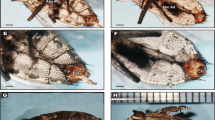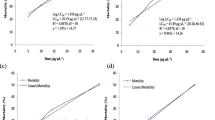Abstract
The blow fly Chrysomya megacephala is a serious medico-veterinary pest causing myiasis in humans and animals apart from transmitting various disease-causing pathogens. Being an economically important pest, it warrants successful control in the early stages without affecting the host, environment, and non-target organisms. Juvenoids being safe, species and stage selective, biodegradable, and harmless to beneficial non-target organisms. Treatment of freshly laid eggs of C. megacephala with juvenoids pyriproxyfen and diofenolan (50 and 100 μg/cm2) by contact method for 1–60 min severely derailed the embryogenesis and postembryonic development. The results included the following: reduced eclosion, dead, non-viable eggs, undeveloped embryos of various stages, and fully developed embryos entrapped in chorion and unable to eclose. Several latent effects of juvenoids were also observed like larval mortality in the first instar, abnormal pupariation, reduced normal pupariation, formation of pupal-adult mosaics, suppression of adult emergence, and emergence of only deformed adults. Diofenolan was found to be more potent than pyriproxyfen in suppressing embryogenesis. These results show that the juvenoids pyriproxyfen and diofenolan have the potential to be judiciously used along with other bio-rational methods for the successful control of C. megacephala.


Similar content being viewed by others
Abbreviations
- Abn Pu:
-
Abnormal pupa
- Ch:
-
Chorion
- DE:
-
Dead eggs
- D Em:
-
Developed embryo
- DL:
-
Dead larva
- E:
-
Eyes
- H Ln:
-
Hatching line
- Mp H:
-
Mouthpart hook
- P:
-
Puparium
- Pu Abd:
-
Pupal abdomen
- Pu Cu:
-
Pupal cuticle
- Rd Abd:
-
Reduced abdomen
- Th:
-
Thorax
- Un Em:
-
Undeveloped embryo
- W:
-
Wing
- W Pri:
-
Wing primordia
References
Bhargava MC, Urs KDC (1993) Ovicidal effect of three insect growth regulators on Corcyra cephalonica. Indian J Plant Prot 21:195–197
Bloem S, Mizell RF, Bloem KA, Hight SD, Carpenter JE (2005) Laboratory evaluation of insecticides for control of the invasive Cactoblastis cactorum (Lepidoptera: Pyralidae). Florida Entomol 88(4):395–400
Boina DR, Rogers ME, Wang N, Stelinski LL (2009) Effect of pyriproxyfen, a juvenile hormone mimic, on egg hatch, nymph development, adult emergence and reproduction of the Asian citrus psyllid, Diaphorina citri Kuwayama. Pest Manag Sci 66:349–357
Canela R, Eizaguirre M, Arquerons X, Estrada J (1995) Activity of several IGRs against Nezara viridula (L.) (Hem., Pentatomidae) eggs. J Appl Entomol 119:699–701
Coats SA (1990) Ovicidal effects of fenoxycarb on eggs of Fuller rose beetle, Pantomorus cervinus (Coleoptera: Curculionidae). Florida Entomol 73(1):187–189
Dhadialla TS, Carlson GR, Le DP (1998) New insecticieds with ecdysteroidal and juvenile hormone activity. Annu Rev Entomol 43:545–569
Dhadialla TS, Retnakaran A, Smagghe G (2005) Insect growth and development disrupting insecticides, In: Gilbert LI, Kostas I, Gill SK (eds) Comprehensive Insect Molecular Science. Vol 6, Pregamon Press, New York, p 55–116
Edwards GC, Braun RP, Wyatt GR (1993) Induction of vitellogenin synthesis in Locusta migratoria by the juvenile hormone analog, pyriproxyfen. J Insect Physiol 39:609–614
Eliahu M, Blumberg D, Horowitz AR, Ishaaya I (2007) Effect of pyriproxyfen on developing stages and embryogenesis of California red scale (CRS), Aonidiella aurantii. Pest Manag Sci 63(8):743–746
Enslee EC, Riddiford LM (1977) Morphological effects of juvenile hormone mimics on embryonic development in the bug, Pyrrhocoris apterus. Rouxs Arch Dev Biol 181:163–181
Erezyilmaz DE, Riddiford LM, Truman JW (2004) Juvenile hormone acts at embryonic molts and induces the nymphal cuticle in the direct-developing cricket. Dev Genes Evol 214:313–323
Ferraz ACP, Proença B, Gadelha BQ, Faria LM, Barbalho MGM, Aguiar- Coelho VM, Lessa CSS (2010) First record of human myiasis caused by association of the species Chrysomya megacephala (Diptera: Calliphoridae), Sarcophaga (Liopygia) ruficornis (Diptera: Sarcophagidae), and Musca domestica (Diptera: Muscidae). J Med Entomol 47(3):487–490
Gardner WA (1991) Ovicidal properties of fenoxycarb against the fall armyworm (Lepidoptera: Noctuidae). Florida Entomol 74(2):257–261
Hazarika LK, Bhuyan M, Hazarika BN (2009) Insect pests of tea and their management. Ann Rev Entomol 54:267–284
Hicks BJ, Gordon R (1992) Effects of the juvenile analog fenoxycarb on various developmental stages of the eastern spruce budworm, Choristoneura fumiferana (Clemens) (Lepidoptera:Tortricidae). Can Entomol 124:117–123
Hirano M, Hatakoshi M, Kawada H, Takimoto Y (1998) Pyriproxyfen and other juvenile hormone analogues. Rev Toxicol 2:375–394
Juri MJD, Zaidenberg M, Santana M (2013) The efficacy of a combined larvicide-adulticide in ultralow volume and fumigant canister formulations in controlling the dengue vector Aedes aegypti (Diptera: Culicidae) in Northwest of Argentina. Parasitol Res 112:1237–1246
Kelly GM, Huebner E (1987) Juvenoid effects on Rhodnius prolixus embryogenesis. Insect Biochem 17(7):1079–1083
Kumarsinghe SPW, Karunaveera ND, Ihalamulla RL (2000) A study of cutaneous myiasis in Sri Lanka. Int J Dermatol 39:689–694
Lienard E, Bouhshira E, Jacquiet P, Warin S, Kaltsatos V, Franc M (2013) Efficacy of dinotefuran, permethrin and pyriproxyfen combination spot-on on dogs against Phlebotomus perniciosus and Ctenocephalides canis. Prarasitol Res 112:3799–3805
Maldonado MA, Centeno N (2003). Quantifying the potential pathogens transmission of the blowflies (Diptera: Calliphoridae). Mem Inst Oswaldo Cruz 98(2):213–216
Marchiondo AA, Riner JL, Sonenshine DE, Rowe KF, Slusser JH (1990) Ovicidal and larvicidal modes of action of fenoxycarb against the cat flea (Siphonaptera: Pulicidae). J Med Entomol 27:913–921
Meola R, Meier K, Dean S, Bhaskaran G (2000) Effect of pyriproxyfen in the blood diet of cat fleas on adult survival, egg viability, and larval development. J Med Entomol 37(4):503–506
Meola S, Palma K, Meola RW (1993) Flea eggs: target of the new IGR on animal treatments. Proc First Int conf Urban Pests 207–213
Mkhize JN (1993) Ovicidal effects of four synthetic juvenile hormone analogues on the confused flour beetle, Tribolium confusum. Insect Sci Appl 14:351–353
Mojaver M, Bandani AR (2010) Effects of the insect growth regulator pyriproxyfen on immature stages of sunn pest, Eurygaster integriceps Puton (Heteroptera: Scutelleridae). Munis Entomol Zool 5(1):187–197
Mondal KAMSH, Parween S, Reichmuth CH, Akhtar N (1999) Effect of triflumuron on the development of the red flour beetle, Tribolium castaneum (Herbst) (Coleoptera: Tenebrionidae). Proc 7th Int Conf Stored Product Prot 1:933–939
Mondal KAMSH, Parween S (2000) Insect growth regulators and their potential in the management of stored-product insect pests. Integ Pest Manag Rev 5:255–295
Nijhout HF (1998) Insect hormones. Princeton University Press, Princeton
Palma KG, Meola SM, Meola RW (1993) Mode of action of pyriproxyfen and methoprene on eggs of Ctenocephalides felis (Siphonaptera: Pulicidae). J Med Entomol 30(2):421–426
Parween S (1996) Distribution and food consumption of larvae and adults of Tribolium castaneum Herbst on Baycidal treated medium. J Biol Sci 4:113–119
Pedigo LP (2002) Entomology and pest management. In: Stewart CE Jr, Yarnell D (eds) 4th edn. Pearson Education, Singapore, pp 742
Radwan WA, Helmy N, Guneidy NA, Mohammed SS (2009) Effect of the juvenile hormone analogue (Admiral) on viability of eggs and postembryonic development of the soft tick Argas persicus (Oken). Egyptian Acad J Biol Sci 2(1):37–45
Rasa CG, Meola RW, Schenker R (2000) Effects of a new insect growth regulator, CGA-255′728, on the different stages of the cat flea (Siphonaptera: Pulicidae). J Med Entomol 37(1):141–145
Rust MK (2005) Advances in the control of Ctenocephalides felis (cat flea) on cats and dogs. Trends Parasitol 21(5):332–336
Seccacini E, Juan L, Zerba E, Licastro S (2014) Aedes aegypti (Diptera: Culicidae): evaluation of natural long-lasting materials containing pyriproxyfen to improve control strategies. Parasitol Res 113:3355–3360
Shaarawi FAI, Radwan WAM, Soliman SA (1982) Effects of juvenoids on some biological aspects of the bed bug Cimex lectularius L. II. Effect on egg viability and embryogenesis. Bull Faculty Sci 6:35–47
Silhacek DL, Dyby S, Murthy C (1994) Use of IGRs for protection of stored commodities from Indian meal moth. Proc Ann Int Res Conf Methyl Bromide Alternatives and Emissions Reductions 98–112
Singh S, Kumar K (2011a) Diofenolan:a novel insect growth regulator in common citrus butterfly, Papilio demoleus. Phytoparasitica 39:205–213
Singh S, Kumar K (2011b) Effect of the juvenile hormone agonist pyriproxyfen on larval and pupal development of the citrus swallowtail Papilio demoleus (Lepidoptera: Papilionidae). Int J Trop Insect Sci 31(3):192–198
Singh S, Kumar K (2011c) Sensitivity of last larval stadium of Chrysomya megacephala (Fabricius) to anti-allatin ageratochromene precocene II. Indian J Exp Biol 49:600–608
Singh S, Kumar K (2015) Effects of juvenoid pyriproxyfen on reproduction and F1 progeny in myiasis causing flesh fly Sarcophaga ruficornis L. (Sarcophagidae: Diptera). Parasitol Res. doi:10.1007/s00436-015-4428-9
Sukontason KL, Bunchoo M, Khantawa B, Piangjai S, Rongsiyam Y, Sukontason K (2007) Comparison between Musca domestica and Chrysomya megacephala as carriers of bacteria in northern Thailand. Southeast Asian J Trop Med Public Health 31(1):38–44
Sullivan JJ, Goh KS (2008) Environmental fate and properties of pyriproxyfen. J Pesticide Sci 33(4):339–350
Teel PD, Donahue WA, Strey OF, Meola RW (1996) Effects of pyriproxyfen on engorged females and newly oviposited eggs of the lone star tick (Acari: Ixodidae). J Med Entomol 33:721–725
Truman JW, Riddiford LM (1999) The origins of insect metamorphosis. Nature 401(6752):447–452
Acknowledgments
I express my gratitude to the Council of Scientific and Industrial Research (CSIR), New Delhi, India for providing financial assistance (Ref No: 09/001/(0376)/2013/EMR-I) and University Grants Commission (UGC), New Delhi for the major research project (F. No. 33-354/2007 (SR)) sanctioned to Prof. Krishna Kumar.
Conflict of interest
The authors declare that they have no conflict of interest.
Compliance with ethical standards
All procedures performed in the study were in accordance with the Guidelines of Institutional Animal Ethics Committee (IAEC) of the Department of Zoology, University of Allahabad.
Author information
Authors and Affiliations
Corresponding author
Rights and permissions
About this article
Cite this article
Singh, S., Kumar, K. Effect of juvenoids pyriproxyfen and diofenolan on embryogenesis and postembryonic development of blow fly Chrysomya megacephala (Diptera: Calliphoridae) following egg treatment. Parasitol Res 114, 3213–3222 (2015). https://doi.org/10.1007/s00436-015-4536-6
Received:
Accepted:
Published:
Issue Date:
DOI: https://doi.org/10.1007/s00436-015-4536-6




